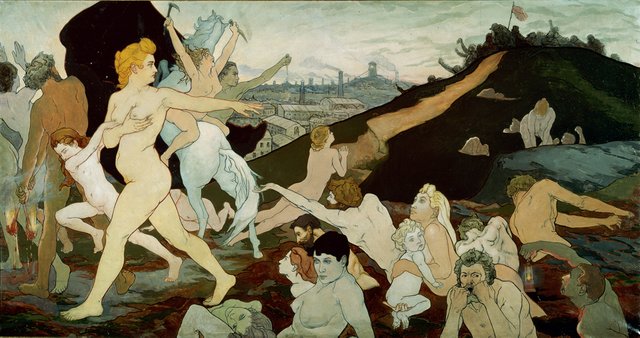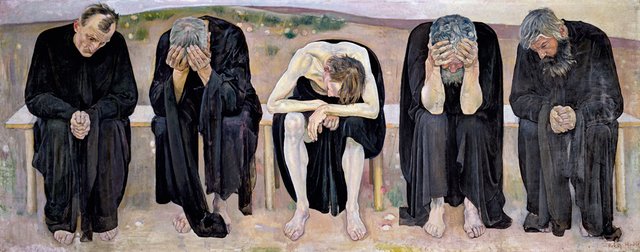A Rose Is a Rose . . . or What?: Guggenheim’s Symbolist Art Show Focuses on ‘Spiritual Abstract Religiosity’

In 1892, the alternately revered and reviled French author and critic Joséphin Péladan assembled a group of artists determined to “overcome European materialism.” What resulted was the formation of the first Salon de la Rose + Croix, an annual exhibition held in Paris that, over the course of six years, helped foment the avant-garde Symbolist art movement.
The thousands of visitors who flocked to those salons responded with a mixture of shock and admiration. In a break from the naturalistic art of the moment, Péladan’s salons featured mythic figures such as the lyre-wielding Orpheus positioned beside androgynous creatures, chimeras, and incubi painted by an international roster of artists, including Antoine Bourdelle, Jean Delville, Charles Filiger, and Ferdinand Hödler. The passing of time would not be kind to the Salon de la Rose + Croix, which soon faded into obscurity—a turn of history that an exhibition at New York’s Guggenheim Museum seeks to amend.

Pierre Amedee Marcel-Beronneau, Orpheus in Hades, 1897, oil on canvas, 76⅜ x 61⅜ inches.
CLAUDE ALMODOVAR/MUSEE DES BEAUX-ARTS, MARSEILLE
The Guggenheim’s organizers—Vivien Greene, senior curator of 19th- and early 20th-century art with assistant curator Ylinka Barotto—chose 40 paintings originally exhibited in the salons for “Mystical Symbolism: The Salon de la Rose+Croix in Paris, 1892–1897.“ Among the works in the show are three portraits of the eccentric Péladan donning robes in a manner befitting the title he bestowed upon himself—Le Sâr (an ancient Assyrian word for “leader” or “king”).
These paintings—which broke from the “no-portraiture” strictures Péladan himself had set—highlight the fact that the Salon was largely buoyed by the cult of personality briefly shrouding its founder. But there had to be more to the events than simply reflecting an organizer with a preternatural grasp for PR. Was there enough, one wonders, to warrant this thorough revisionist retrospective more than a century later?
Charles Maurin’s triptych Dawn is one work that stands out against the rest. Adopting a graphic style akin to Japanese lithographs, Maurin rendered a scene rich in social allegory and quite out of step with the more idealist works with which it shared wall space at the time. L’aurore du travail (The Dawn of Labor, 1891), for example, features a bevy of naked men and women in the throes of an uprising, which curator Vivien Greene explains in an accompanying catalogue essay as Maurin’s anti-capitalist depiction of a miner’s uprising.
Not all the Salon artists followed Maurin’s political bent, but they did adopt a collective stand against a late-19th-century trend toward positivism that emphasized knowledge gained through empirical understanding. In essence, the works of the Salon de la Rose + Croix shared in a pursuit of art that would serve some higher purpose—an aim described by Greene as a “spiritual abstract religiosity.”

Ferdinand Hodler, Les âmes déçues (The Disappointed Souls), 1892, oil on canvas, 47¼ x 117¾ inches.
KUNTSMUSEUM BERN, STAAT BERN
The exhibition has been framed as a way to reposition both the Salon and Symbolist art’s influence on modernism and figureheads such as Kandinsky and Mondrian. But is it coincidental—or perhaps opportunistic—that such a show should come at a time when our present-day society is facing a sense of uncertainty akin to that of the original Salon?
Unless some lesser offerings, Ferdinand Hödler’s Les âmes déçues (The Disappointed Souls, 1892) is a work that has aged well, with a row of men clothed in black gowns sitting and looking thoroughly depressed. The mood, the catalogue suggests, is consistent with the Salon’s creed: to draw a viewer “into contemplation of the human condition.”
Intentional or not, this impulse embedded in Péladan’s salon has regained a certain relevance in 2017. The last time around, this sort of questioning led to modernism. Which leaves us now to wonder: what next?
Source- http://www.artnews.com/2017/09/06/a-rose-is-a-rose-or-what-guggenheims-symbolist-art-show-focuses-on-spiritual-abstract-religiosity/
Not indicating that the content you copy/paste is not your original work could be seen as plagiarism.
Some tips to share content and add value:
Repeated plagiarized posts are considered spam. Spam is discouraged by the community, and may result in action from the cheetah bot.
Creative Commons: If you are posting content under a Creative Commons license, please attribute and link according to the specific license. If you are posting content under CC0 or Public Domain please consider noting that at the end of your post.
If you are actually the original author, please do reply to let us know!
Thank You!
Nice to see somebody posting about fine art. Thanks.
Hi! I am a robot. I just upvoted you! I found similar content that readers might be interested in:
http://www.artnews.com/2017/09/06/a-rose-is-a-rose-or-what-guggenheims-symbolist-art-show-focuses-on-spiritual-abstract-religiosity/